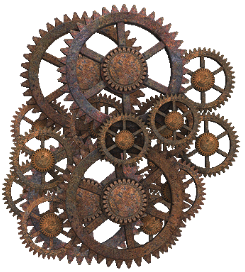




Steam Punk Original Designs -








View handcrafted and original ‘curious contraptions’ in the online shop.


Some of the content on this website was obtained using the Creative Commons License
MORE INFORMATION






Jules Verne
Jules Gabriel Verne; 8 February 1828 – 24 March 1905) was a French novelist, poet, and playwright best known for his adventure novels and his profound influence on the literary genre of science fiction.
Verne was born to bourgeois parents in the seaport of Nantes, where he was trained to follow in his father's footsteps as a lawyer, but quit the profession early in life to write for magazines and the stage. His collaboration with the publisher Pierre-
Verne is generally considered a major literary author in France and most of Europe, where he has had a wide influence on the literary avant-
Verne has been the second most-
Thanks to his visits to salons, Verne came into contact in 1849 with Alexandre Dumas through the mutual acquaintance of a celebrated chirologist of the time, the Chevalier d'Arpentigny. Verne became close friends with Dumas' son, Alexandre Dumas, fils, and showed him a manuscript for a stage comedy, Les Pailles rompues (The Broken Straws). The two young men revised the play together, and Dumas, through arrangements with his father, had it produced by the Opéra-
In 1851, Verne met with a fellow writer from Nantes, Pierre-
Dumas fils put Verne in contact with Jules Seveste, a stage director who had taken over the directorship of the Théâtre-
For some time, Verne's father pressed him to abandon his writing and begin a business as a lawyer. However, Verne argued in his letters that he could only find success in literature. The pressure to plan for a secure future in law reached its climax in January 1852, when his father offered Verne his own Nantes law practice. Faced with this ultimatum, Verne decided conclusively to continue his literary life and refuse the job, writing: "Am I not right to follow my own instincts? It's because I know who I am that I realize what I can be one day."
Meanwhile, Verne was spending much time at the Bibliothèque nationale de France, conducting research for his stories and feeding his passion for science and recent discoveries, especially in geography. It was in this period that Verne met the illustrious geographer and explorer Jacques Arago, who continued to travel extensively despite his blindness (he had lost his sight completely in 1837). The two men became good friends, and Arago's innovative and witty accounts of his travels led Verne toward a newly developing genre of literature: that of travel writing.
In 1852, two new pieces from Verne appeared in the Musée des familles: "Martin Paz", a novella set in Lima, which Verne wrote in 1851 and published 10 July through 11 August 1852, and Les Châteaux en Californie, ou, Pierre qui roule n’amasse pas mousse (The Castles in California, or, A Rolling Stone Gathers No Moss), a one-
While writing stories and articles for Pitre-
In 1862, through their mutual acquaintance Alfred de Bréhat, Verne came into contact with the publisher Pierre-
To secure his services for the planned magazine, to be called the Magasin d'Éducation et de Récréation (Magazine of Education and Recreation), Hetzel also drew up a long-
When The Adventures of Captain Hatteras was published in book form in 1866, Hetzel publicly announced his literary and educational ambitions for Verne's novels by saying in a preface that Verne's works would form a novel sequence called the Voyages extraordinaires (Extraordinary Voyages or Extraordinary Journeys), and that Verne's aim was "to outline all the geographical, geological, physical, and astronomical knowledge amassed by modern science and to recount, in an entertaining and picturesque format that is his own, the history of the universe." Late in life, Verne confirmed that this commission had become the running theme of his novels: "My object has been to depict the earth, and not the earth alone, but the universe… And I have tried at the same time to realize a very high ideal of beauty of style. It is said that there can't be any style in a novel of adventure, but it isn't true." However, he also noted that the project was extremely ambitious: "Yes! But the Earth is very large, and life is very short! In order to leave a completed work behind, one would need to live to be at least 100 years old!"
Hetzel influenced many of Verne's novels directly, especially in the first few years of their collaboration, for Verne was initially so happy to find a publisher that he agreed to almost all of the changes Hetzel suggested. For example, when Hetzel disapproved of the original climax of Captain Hatteras, including the death of the title character, Verne wrote an entirely new conclusion in which Hatteras survived.[71] Hetzel also rejected Verne's next submission, Paris in the Twentieth Century, believing its pessimistic view of the future and its condemnation of technological progress were too subversive for a family magazine.[72] (The manuscript, believed lost for some time after Verne's death, was finally published in 1994.)
In 1867, Verne bought a small ship, the Saint-
The decades after Verne's death saw the rise in France of the "Jules Verne cult", a steadily growing group of scholars and young writers who took Verne's works seriously as literature and willingly noted his influence on their own pioneering works. Some of the cult founded the Sociéte Jules Verne, the first academic society for Verne scholars; many others became highly respected avant garde and surrealist literary figures in their own right. Their praise and analyses, emphasizing Verne's stylistic innovations and enduring literary themes, proved highly influential for literary studies to come.
In the 1960s and 1970s, thanks in large part to a sustained wave of serious literary study from well-
French literary journals devoted entire issues to Verne and his work, with essays by such imposing literary figures as Michel Butor, Georges Borgeaud, Marcel Brion, Pierre Versins, Michel Foucault, René Barjavel, Marcel Lecomte, Francis Lacassin, and Michel Serres; meanwhile, Verne's entire published opus returned to print, with unabridged and illustrated editions of his works printed by Livre de Poche and Éditions Rencontre. The wave reached its climax in Verne's sesquicentennial year 1978, when he was made the subject of an academic colloquium at the Centre culturel international de Cerisy-
Verne's novels have had a wide influence on both literary and scientific works; writers known to have been influenced by Verne include Marcel Aymé, Roland Barthes, René Barjavel, Michel Butor, Blaise Cendrars, Paul Claudel, Jean Cocteau, François Mauriac, Raymond Roussel, Claude Roy, Antoine Saint-
| What Is Steampunk |
| Steam Punk Fashion and Literature |
| Steam Punk Culture & Community |
| Steam Punk Styles & Settings |
| Steam Punk Music, TV and Films |
| Steam Punk Art & Design |
| Search for Steampunk Info |
| Steampunk Guns |
| Steampunk Goggles |
| Steampunk Hats |